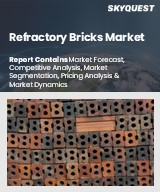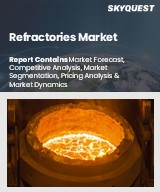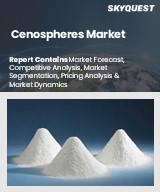
|
시장보고서
상품코드
1679209
재활용 내화물 시장 예측(-2030년) : 형태, 재료, 프로세스, 용도, 최종사용자, 지역별 세계 분석Recycled Refractories Market Forecasts to 2030 - Global Analysis By Form (Granules, Powder, Bricks & Blocks and Other Forms), Material, Process, Application, End User and By Geography |
||||||
Stratistics MRC에 따르면 세계의 재활용 내화물 시장은 2024년에 137억 2,000만 달러를 차지하며 2030년에는 225억 3,000만 달러에 달할 것으로 예측되며, 예측 기간 중 CAGR은 10.8%로 성장할 전망입니다.
재활용 내화물은 산업용 재사용을 위해 가공 및 재사용된 사용 후 내화물입니다. 이러한 재료는 용광로, 가마, 도가니에서 사용한 내화물 라이닝에서 유래하며, 분쇄, 세척, 구성 및 품질에 따라 등급을 매겨집니다. 내화물의 재활용은 폐기물을 줄이고, 원자재 비용을 절감하며, 환경에 미치는 영향을 최소화하는 데 도움이 됩니다.
미국 환경보호청(EPA)에 따르면 재료의 재활용과 재사용은 온실가스 배출을 크게 줄일 수 있으며, 전 세계에서 재활용률이 높아지면 연간 최대 25억 톤의 CO2를 감축할 수 있다고 합니다.
순환 경제와 탄소발자국 감소에 대한 중요성 증대
정부와 조직은 환경 규제를 강화하고 폐기물과 이산화탄소 배출을 최소화하기 위해 재료의 재사용을 장려하고 있습니다. 내화물의 재활용은 처녀 원료에 대한 의존도를 줄이고 에너지 소비와 생산 비용을 절감합니다. 이러한 자원 효율성과 환경 부하 감소로의 전환은 재활용 내화물 수요를 증가시켜 시장 성장과 지속가능한 내화물 가공 기술의 혁신을 촉진할 것입니다.
재활용 재료의 일관성 없는 특성
재활용 내화물은 원료의 편차, 오염, 이전 사용으로 인한 마모로 인해 특성이 일정하지 않습니다. 다양한 작동 조건, 불순물, 화학적 변화가 재활용 재료의 품질과 성능에 영향을 미칩니다. 이러한 일관성이 없기 때문에 균일한 강도, 내열성 및 내구성을 유지하기가 어렵고 고성능 용도에 대한 적합성을 제한합니다. 그 결과, 품질의 불확실성은 수요를 감소시키고, 산업계의 폭넓은 수용을 지연시킴으로써 시장 성장을 저해하고 있습니다.
철강-시멘트 산업의 성장
철강 및 시멘트 산업은 고온의 용광로와 가마에 크게 의존하고 있으며, 내화 라이닝이 필요하지만 시간이 지남에 따라 마모됩니다. 이러한 사용한 내화물을 재활용하면 원자재 비용을 절감하고 지속가능성 목표에 부합합니다. 또한 인프라 프로젝트와 산업화의 발전은 내화물의 소비를 증가시켜 재활용 가능한 재료의 안정적인 공급을 창출하고 있습니다. 엄격한 환경 규제가 강화됨에 따라 철강 및 시멘트 제조업체들은 재활용 내화물의 채택을 늘리고 있으며, 이는 시장 확대를 촉진하고 전 세계에서 환경 친화적인 산업 관행을 촉진하고 있습니다.
높은 가공 비용
재활용 내화물은 품질과 일관성을 보장하기 위해 노동 집약적인 선별, 세척, 분쇄 및 등급을 매기는 공정이 필요하므로 가공 비용이 높습니다. 오염 물질, 마모로 인한 특성 변화, 내화물의 성능 회복을 위한 첨단 기술의 필요성으로 인해 비용은 더욱 증가합니다. 또한 제한된 재활용 인프라와 표준화된 처리 기술의 부족은 공급망의 비효율성을 초래하여 지속가능한 내화물 솔루션에 대한 수요 증가에도 불구하고 시장 확장을 더욱 제한하고 있습니다.
COVID-19의 영향:
COVID-19는 공급망 중단, 산업 활동 감소, 노동력 부족을 초래하여 재활용 내화물 시장을 혼란에 빠뜨렸습니다. 철강, 시멘트, 유리 산업의 둔화는 내화물 수요 감소로 이어졌습니다. 그러나 팬데믹 이후 회복과 지속가능성에 대한 관심이 다시 높아지면서 재활용 소재에 대한 관심이 높아졌습니다. 단기적인 혼란은 컸지만, 순환 경제에 대한 노력 증가와 환경 규제 강화로 인해 장기적인 시장 성장이 기대됩니다.
예측 기간 중, 용광로 및 가마 부문이 가장 클 것으로 예상됩니다.
예측 기간 중 용광로 및 가마 부문이 가장 큰 시장 점유율을 차지할 것으로 예상됩니다. 용광로 및 가마에서 재활용 내화물은 고온 용도에서 비용 효율성과 지속가능성을 높이기 위해 사용됩니다. 사용 후 내화 라이닝에서 유래한 이 재료는 단열재, 라이닝, 구조 부품에 사용하기 위해 가공 및 재사용됩니다. 가공 기술의 발전으로 재활용 내화물의 특성이 개선되어 용광로와 가마의 수명을 연장하는 데 있으며, 실행 가능한 선택이 되었습니다.
예측 기간 중 유리 제조 분야는 가장 높은 CAGR을 보일 것으로 예상됩니다.
예측 기간 중 유리 제조 분야가 가장 높은 성장률을 보일 것으로 예상됩니다. 유리 제조에서 재활용 내화물은 고온 저항을 유지하면서 비용과 환경 영향을 줄이기 위해 사용됩니다. 유리 산업은 버진 내화물에 대한 의존도를 줄이고 지속가능성에 대한 노력에 부합하는 이점이 있습니다. 유리 산업은 버진 내화물에 대한 의존도를 줄이고 지속가능성에 대한 노력에 동참함으로써 이익을 얻습니다.
가장 큰 점유율을 가진 지역:
예측 기간 중 아시아태평양은 특히 철강, 시멘트, 유리 생산과 같은 산업 기반이 견고하여 가장 큰 시장 점유율을 차지할 것으로 예상됩니다. 중국, 인도, 일본은 대규모 제조업과 지속가능한 관행을 장려하는 엄격한 환경 규제로 인해 주요 기여국이 되었습니다. 폐기물 감소와 순환 경제 실천을 지원하기 위한 정부의 구상은 재활용 내화물의 채택을 촉진하고 있으며, 아시아태평양은 산업 용도에서 재활용 내화물의 성장 거점이 되고 있습니다.
CAGR이 가장 높은 지역:
예측 기간 중 북미가 가장 높은 CAGR을 보일 것으로 예상됩니다. 이는 지속가능성에 대한 노력의 확대, 엄격한 환경 규제, 철강, 시멘트, 유리 등의 산업에서 비용 절감 조치 증가에 기인합니다. 미국과 캐나다는 첨단인 재활용 인프라와 순환 경제 관행의 채택 증가로 시장을 선도하고 있습니다. 기술 발전과 규제 지원으로 시장이 성장하고 산업 전반에 걸쳐 지속가능한 내화물 사용을 촉진할 것으로 예상됩니다.
무료 커스터마이징 서비스:
이 보고서를 구독하는 고객은 다음과 같은 무료 맞춤화 옵션 중 하나를 이용할 수 있습니다.
- 기업소개
- 추가 시장 기업의 종합 프로파일링(최대 3사)
- 주요 기업의 SWOT 분석(최대 3사)
- 지역 세분화
- 고객의 관심에 따른 주요 국가별 시장 추정, 예측, CAGR(주: 타당성 확인에 따라 다름)
- 경쟁사 벤치마킹
- 제품 포트폴리오, 지역적 입지, 전략적 제휴에 기반한 주요 기업의 벤치마킹
목차
제1장 개요
제2장 서문
- 개요
- 이해관계자
- 조사 범위
- 조사 방법
- 데이터 마이닝
- 데이터 분석
- 데이터 검증
- 조사 어프로치
- 조사 정보원
- 1차 조사 정보원
- 2차 조사 정보원
- 전제조건
제3장 시장 동향 분석
- 촉진요인
- 억제요인
- 기회
- 위협
- 용도 분석
- 최종사용자 분석
- 신흥 시장
- COVID-19의 영향
제4장 Porter's Five Forces 분석
- 공급 기업의 교섭력
- 바이어의 교섭력
- 대체품의 위협
- 신규 진출업체의 위협
- 경쟁 기업 간 경쟁 관계
제5장 세계의 재활용 내화물 시장 : 형태별
- 과립
- 분말
- 벽돌과 블록
- 기타 형태
제6장 세계의 재활용 내화물 시장 : 재료별
- 내화점토
- 마그네사이트
- 알루미나
- 실리콘 카바이드
- 지르코니아
- 기타 재료
제7장 세계의 재활용 내화물 시장 : 프로세스별
- 분쇄와 연삭
- 선별과 분리
- 정제
- 혼합과 재처리
- 기타 프로세스
제8장 세계의 재활용 내화물 시장 : 용도별
- 노 및 가마
- 래들 라이닝
- 턴디쉬 라이닝
- 보일러와 소각로
- 기타 용도
제9장 세계의 재활용 내화물 시장 : 최종사용자별
- 철강
- 시멘트와 석회
- 유리 제조
- 에너지와 전력
- 세라믹·화학제품
- 기타 최종사용자
제10장 세계의 재활용 내화물 시장 : 지역별
- 북미
- 미국
- 캐나다
- 멕시코
- 유럽
- 독일
- 영국
- 이탈리아
- 프랑스
- 스페인
- 기타 유럽
- 아시아태평양
- 일본
- 중국
- 인도
- 호주
- 뉴질랜드
- 한국
- 기타 아시아태평양
- 남미
- 아르헨티나
- 브라질
- 칠레
- 기타 남미
- 중동 및 아프리카
- 사우디아라비아
- 아랍에미리트
- 카타르
- 남아프리카공화국
- 기타 중동 및 아프리카
제11장 주요 발전
- 계약, 파트너십, 협업, 합병사업
- 인수와 합병
- 신제품 발매
- 사업 확대
- 기타 주요 전략
제12장 기업 프로파일링
- Saint-Gobain
- Krosaki Harima Corporation
- Deref S.p.A.
- Harsco Corporation
- HORN & CO. GROUP
- LKAB Minerals
- Mineralen Kollee
- REF Minerals
- RHI Magnesita
- Jai Balajee Trading Co.
- Refratechnik
- Vesuvius
- Imerys
- HarbisonWalker International
- Veolia
According to Stratistics MRC, the Global Recycled Refractories Market is accounted for $13.72 billion in 2024 and is expected to reach $22.53 billion by 2030 growing at a CAGR of 10.8% during the forecast period. Recycled refractories are used refractory materials that have been processed and repurposed for reuse in industrial applications. These materials originate from worn-out refractory linings in furnaces, kilns, and ladles, which are crushed, cleaned, and graded based on composition and quality. Recycling refractories helps reduce waste, lower raw material costs, and minimize environmental impact.
According to the Environmental Protection Agency (EPA), recycling and reuse of materials can significantly reduce greenhouse gas emissions, with a potential reduction of up to 2.5 billion metric tons of CO2 equivalent per year if recycling rates increase globally.
Market Dynamics:
Driver:
Growing emphasis on circular economy & carbon footprint reduction
Governments and organizations are enforcing stricter environmental regulations, promoting the reuse of materials to minimize waste and carbon emissions. Recycling refractories reduces dependence on virgin raw materials, lowering energy consumption and production costs. This shift toward resource efficiency and reduced environmental impact boosts demand for recycled refractories, fostering market growth and innovation in sustainable refractory processing technologies.
Restraint:
Inconsistent properties of recycled materials
Recycled refractories have inconsistent properties due to variations in raw materials, contamination, and wear from previous use. Different operating conditions, impurities, and chemical alterations affect the quality and performance of recycled materials. This inconsistency makes it difficult to maintain uniform strength, thermal resistance, and durability, limiting their suitability for high-performance applications. As a result, quality uncertainties hamper market growth by reducing demand and slowing widespread industrial acceptance.
Opportunity:
Steel & cement industry growth
Steel and cement industries rely heavily on high-temperature furnaces and kilns, which require refractory linings that wear out over time. Recycling these used refractories reduces raw material costs and aligns with sustainability goals. Additionally, rising infrastructure projects and industrialization boost refractory consumption, creating a steady supply of recyclable materials. With stringent environmental regulations initiatives gaining traction, steel and cement manufacturers increasingly adopt recycled refractories, propelling market expansion and fostering eco-friendly industrial practices worldwide.
Threat:
High processing costs
Recycled refractories have high processing costs due to labor-intensive sorting, cleaning, crushing, and grading processes required to ensure quality and consistency. Contaminants, wear-induced property variations, and the need for advanced technology to restore refractory performance further increase expenses. Additionally, limited recycling infrastructure and lack of standardized processing techniques create supply chain inefficiencies, further restricting market expansion despite growing demand for sustainable refractory solutions.
Covid-19 Impact:
The covid-19 pandemic disrupted the recycled refractories market by causing supply chain interruptions, reduced industrial activity, and labor shortages. The slowdown in steel, cement, and glass industries led to lower demand for refractories. However, post-pandemic recovery and renewed emphasis on sustainability boosted interest in recycled materials. While short-term disruptions were significant, long-term market growth is expected due to increasing circular economy initiatives and stricter environmental regulations.
The furnaces & kilns segment is expected to be the largest during the forecast period
The furnaces & kilns segment is expected to account for the largest market share during the forecast period. Recycled refractories in furnaces and kilns are used to enhance cost efficiency and sustainability in high-temperature applications. These materials, derived from spent refractory linings, are processed and repurposed for use in insulation, linings, and structural components. Advancements in processing technology are improving recycled refractory properties, making them a viable alternative for extending furnace and kiln lifespan.
The glass manufacturing segment is expected to have the highest CAGR during the forecast period
Over the forecast period, the glass manufacturing segment is predicted to witness the highest growth rate. Recycled refractories in glass manufacturing are used to reduce costs and environmental impact while maintaining high-temperature resistance. The glass industry benefits from reduced dependency on virgin refractory materials, aligning with sustainability initiatives. The glass industry benefits from reduced dependency on virgin refractory materials, aligning with sustainability initiatives.
Region with largest share:
During the forecast period, the Asia Pacific region is expected to hold the largest market share due to the region's strong industrial base, particularly in steel, cement, and glass production. China, India, and Japan are key contributors due to their large-scale manufacturing and stringent environmental regulations promoting sustainable practices. Government initiatives supporting waste reduction and circular economy practices are boosting adoption, making Asia-Pacific a growing hub for recycled refractory materials in industrial applications.
Region with highest CAGR:
Over the forecast period, the North America region is anticipated to exhibit the highest CAGR, driven by growing sustainability initiatives, stringent environmental regulations, and cost-saving measures in industries like steel, cement, and glass. The U.S. and Canada lead the market with advanced recycling infrastructure and increasing adoption of circular economy practices. With technological advancements and regulatory support, the market is expected to grow, promoting sustainable refractory usage across industrial applications.
Key players in the market
Some of the key players in Recycled Refractories market include Saint-Gobain, Krosaki Harima Corporation, Deref S.p.A., Harsco Corporation, HORN & CO. GROUP, LKAB Minerals, Mineralen Kollee, REF Minerals, RHI Magnesita, Jai Balajee Trading Co., Refratechnik, Vesuvius, Imerys, HarbisonWalker International and Veolia.
Key Developments:
In January 2025, RHI Magnesita, in collaboration with MCi Carbon, the Austrian Institute of Technology, and the University of Technology Sydney, received €3.8 million in funding for the CCUpScale project. This initiative aims to develop carbon capture and utilization solutions within the refractory industry.
In October 2024, Saint-Gobain introduced RenuCore(TM), an innovative roofing solution that incorporates recycled materials, reducing waste and environmental impact. The introduction of this product aligns with the growing industry trend toward eco-friendly construction materials, reinforcing Saint-Gobain's leadership in sustainable building solutions and its dedication to reducing carbon footprints in the construction sector.
Forms Covered:
- Granules
- Powder
- Bricks & Blocks
- Other Forms
Materials Covered:
- Fireclay
- Magnesite
- Alumina
- Silicon Carbide
- Zirconia
- Other Materials
Processes Covered:
- Crushing & Grinding
- Sorting & Separation
- Purification
- Mixing & Reprocessing
- Other Processes
Applications Covered:
- Furnaces & Kilns
- Ladle Linings
- Tundish Linings
- Boilers & Incinerators
- Other Applications
End Users Covered:
- Iron & Steel
- Cement & Lime
- Glass Manufacturing
- Energy & Power
- Ceramics & Chemicals
- Other End Users
Regions Covered:
- North America
- US
- Canada
- Mexico
- Europe
- Germany
- UK
- Italy
- France
- Spain
- Rest of Europe
- Asia Pacific
- Japan
- China
- India
- Australia
- New Zealand
- South Korea
- Rest of Asia Pacific
- South America
- Argentina
- Brazil
- Chile
- Rest of South America
- Middle East & Africa
- Saudi Arabia
- UAE
- Qatar
- South Africa
- Rest of Middle East & Africa
What our report offers:
- Market share assessments for the regional and country-level segments
- Strategic recommendations for the new entrants
- Covers Market data for the years 2022, 2023, 2024, 2026, and 2030
- Market Trends (Drivers, Constraints, Opportunities, Threats, Challenges, Investment Opportunities, and recommendations)
- Strategic recommendations in key business segments based on the market estimations
- Competitive landscaping mapping the key common trends
- Company profiling with detailed strategies, financials, and recent developments
- Supply chain trends mapping the latest technological advancements
Free Customization Offerings:
All the customers of this report will be entitled to receive one of the following free customization options:
- Company Profiling
- Comprehensive profiling of additional market players (up to 3)
- SWOT Analysis of key players (up to 3)
- Regional Segmentation
- Market estimations, Forecasts and CAGR of any prominent country as per the client's interest (Note: Depends on feasibility check)
- Competitive Benchmarking
- Benchmarking of key players based on product portfolio, geographical presence, and strategic alliances
Table of Contents
1 Executive Summary
2 Preface
- 2.1 Abstract
- 2.2 Stake Holders
- 2.3 Research Scope
- 2.4 Research Methodology
- 2.4.1 Data Mining
- 2.4.2 Data Analysis
- 2.4.3 Data Validation
- 2.4.4 Research Approach
- 2.5 Research Sources
- 2.5.1 Primary Research Sources
- 2.5.2 Secondary Research Sources
- 2.5.3 Assumptions
3 Market Trend Analysis
- 3.1 Introduction
- 3.2 Drivers
- 3.3 Restraints
- 3.4 Opportunities
- 3.5 Threats
- 3.6 Application Analysis
- 3.7 End User Analysis
- 3.8 Emerging Markets
- 3.9 Impact of Covid-19
4 Porters Five Force Analysis
- 4.1 Bargaining power of suppliers
- 4.2 Bargaining power of buyers
- 4.3 Threat of substitutes
- 4.4 Threat of new entrants
- 4.5 Competitive rivalry
5 Global Recycled Refractories Market, By Form
- 5.1 Introduction
- 5.2 Granules
- 5.3 Powder
- 5.4 Bricks & Blocks
- 5.5 Other Forms
6 Global Recycled Refractories Market, By Material
- 6.1 Introduction
- 6.2 Fireclay
- 6.3 Magnesite
- 6.4 Alumina
- 6.5 Silicon Carbide
- 6.6 Zirconia
- 6.7 Other Materials
7 Global Recycled Refractories Market, By Process
- 7.1 Introduction
- 7.2 Crushing & Grinding
- 7.3 Sorting & Separation
- 7.4 Purification
- 7.5 Mixing & Reprocessing
- 7.6 Other Processes
8 Global Recycled Refractories Market, By Application
- 8.1 Introduction
- 8.2 Furnaces & Kilns
- 8.3 Ladle Linings
- 8.4 Tundish Linings
- 8.5 Boilers & Incinerators
- 8.6 Other Applications
9 Global Recycled Refractories Market, By End User
- 9.1 Introduction
- 9.2 Iron & Steel
- 9.3 Cement & Lime
- 9.4 Glass Manufacturing
- 9.5 Energy & Power
- 9.6 Ceramics & Chemicals
- 9.7 Other End Users
10 Global Recycled Refractories Market, By Geography
- 10.1 Introduction
- 10.2 North America
- 10.2.1 US
- 10.2.2 Canada
- 10.2.3 Mexico
- 10.3 Europe
- 10.3.1 Germany
- 10.3.2 UK
- 10.3.3 Italy
- 10.3.4 France
- 10.3.5 Spain
- 10.3.10 Rest of Europe
- 10.4 Asia Pacific
- 10.4.1 Japan
- 10.4.2 China
- 10.4.3 India
- 10.4.4 Australia
- 10.4.5 New Zealand
- 10.4.10 South Korea
- 10.4.7 Rest of Asia Pacific
- 10.5 South America
- 10.5.1 Argentina
- 10.5.2 Brazil
- 10.5.3 Chile
- 10.5.4 Rest of South America
- 10.1 Middle East & Africa
- 10.10.1 Saudi Arabia
- 10.10.2 UAE
- 10.10.3 Qatar
- 10.10.4 South Africa
- 10.10.5 Rest of Middle East & Africa
11 Key Developments
- 11.1 Agreements, Partnerships, Collaborations and Joint Ventures
- 11.2 Acquisitions & Mergers
- 11.3 New Product Launch
- 11.4 Expansions
- 11.5 Other Key Strategies
12 Company Profiling
- 12.1 Saint-Gobain
- 12.2 Krosaki Harima Corporation
- 12.3 Deref S.p.A.
- 12.4 Harsco Corporation
- 12.5 HORN & CO. GROUP
- 12.6 LKAB Minerals
- 12.7 Mineralen Kollee
- 12.8 REF Minerals
- 12.9 RHI Magnesita
- 12.10 Jai Balajee Trading Co.
- 12.11 Refratechnik
- 12.12 Vesuvius
- 12.13 Imerys
- 12.14 HarbisonWalker International
- 12.15 Veolia



















